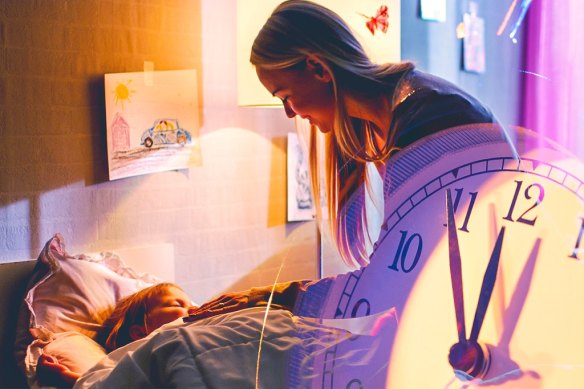This was published 7 months ago
Tonight is the last night to help your kids adjust to the end of daylight saving
By Nell Geraets
The long, warm days of summer are officially behind us. Daylight saving will come to an end on Sunday morning, shifting our clocks back one hour.
For many, this change is welcome – who doesn’t want an extra hour of sleep? – but for others, it’s an uncertain period that could throw their children’s sleep schedule entirely out of whack.

Daylight saving is a challenge for parents and kids alike.Credit: Illustration: Bethany Rae
So, how can parents help their little ones adjust to the end of daylight saving, ensuring they get the sleep they need without waking the whole household at the crack of dawn?
What is daylight saving?
Daylight saving was introduced to ensure we have maximum natural light during waking hours, regardless of the season. In Australia, Victoria, Tasmania, New South Wales, South Australia, ACT and Norfolk Island have implemented the time change.
At 3am on Sunday, April 7 – the first Sunday of April – clocks will shift back by an hour, meaning the mornings will be lighter, but the sun will set an hour earlier in the evenings. Daylight saving will recommence in spring, at 2am on October 6, when clocks jump forward an hour.
Why does this matter?
Sleep expert and co-founder of The Goodnight Co. Shea Morrison says daylight saving can shift our internal body clock, which controls our circadian rhythm that regulate things like metabolism, cognitive function and sleep. While the effects of daylight saving tend to be more severe in spring, when we lose an hour of sleep, people still tend to notice a change in the quality and length of sleep in autumn, akin to the feelings of jet lag.
“It can be like the feeling you get when you change timezones – fatigue, moodiness, fogginess, maybe a loss of appetite, perhaps a bit of lightheadedness,” Morrison says.
This can be more pronounced among children and teenagers, who depend on consistent sleep patterns for physical and mental development.
“Sleep is when they’re consolidating learning and memory. It’s helping them regulate their emotions and mood. If your sleep is thrown off, it’s going to be really hard to get through the day, particularly as a child,” Morrison says.
Director of the University of Melbourne’s Sleep Laboratory, Professor Amy Jordan, notes that the degree to which one struggles with these changes will depend on the length of their natural sleep cycle.
“Our internal body clock, or circadian rhythm, doesn’t run at exactly 24 hours, and it differs between individuals. Someone whose body clock naturally runs a bit longer, say 24.8 hours, will find it easier to delay their clock and adjust to the autumn change than someone whose body clock is exactly 24 hours,” Jordan says.
How can I help my child adjust?
Unlike parents (who will probably celebrate the fact they get an extra hour of sleep), children are more likely to wake up around the same time. For example, if a child usually wakes up at 6am, they will wake up at 5am once daylight saving ends.
To avoid being woken up before sunrise, the director of Melbourne Children’s Sleep Centre at Monash Children’s Hospital, Margot Davey, suggests gradually delaying your child’s nighttime routine.
“That’s not just bedtime, it’s all the things our circadian rhythm is influenced by,” Davey says. “That includes meals and sunlight exposure. I’d try to increase their sunlight exposure in the late afternoon, delay their evening meal, and try to delay their bedtime by about 10 to 15 minutes every four or five days. It may be best to try this over the two weeks leading up to daylight saving.”
This can be fast-tracked, however, by delaying their bedtime by 20 minutes over three nights, or even by 30 minutes over two nights.
Children with developmental conditions, such as autism spectrum disorder, can take a while to adapt to these kinds of changes and will therefore probably respond best to a more gradual process, Davey notes.
What if that doesn’t work?
If your child is struggling to adjust, Morrison suggests getting them outside shortly after waking up, perhaps with an outdoors breakfast or a quick walk around the park.
“Getting outside when the sun comes out, even just for five minutes, can help set our circadian rhythm. When we get that morning sunlight, it stops the production of melatonin, which is the sleep hormone. That gives us the feeling of energy and alertness.”
Consistency is also key, Morrison says, noting that regular nighttime and morning routines should be adhered to regardless of how long it takes your child to adjust.
“It might take a little longer, a couple of weeks versus a couple of days,” she says. “But sticking to a fairly consistent routine will help realign their circadian rhythms and improve their bodily functions.”
Make the most of your health, relationships, fitness and nutrition with our Live Well newsletter. Get it in your inbox every Monday.